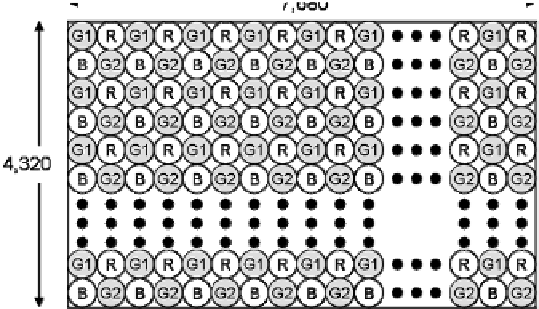Information Technology Reference
In-Depth Information
2036-1, which describes the video formats for ultra high-definition TV (UHDTV) sys-
tem [9]. It corresponds with the ITU-R recommendations.
NHK has developed key equipment for SHV broadcasting systems, such as
cameras, display systems, and disk recorders. SHV requires an imaging device and
display device with 33 million pixels; however, integrated devices with such high
resolution are not yet available. Thus, the SHV camera uses four panels with 8
million pixels each for green 1 (G1), green 2 (G2) (dual-green), red (R), and blue
(B) channels, using the pixel-offset method to increase the effective number of
pixels both horizontally and vertically. Figure 1 shows the pixel-spatial-sampling
arrangement in this method.
Fig. 1
Pixel-spatial-sampling arrangement in pixel offset method
2.2 Audio System of SHV
The audio format of the SHV system has 22.2 multi-channel sounds as shown in
Figure 2 and Table 2. The 22.2 multichannel sound system has 3 loudspeaker lay-
ers (top, middle, and bottom), 22 full-bandwidth channels, and 2 low frequency ef-
fects (LFE) channels. It is a three-dimensional audio system, whereas the 5.1 mul-
tichannel sound system specified in ITU-R BS.775-2 is a two-dimensional audio
system without a vertical dimension [10].
The audio sampling frequency is 48 kHz, and 96 kHz can be optionally applied.
The bit depth is 16, 20, or 24 bits per audio sample.
International standardization of the 22.2 multichannel sound system is currently
underway. ITU-R is studying the system parameters for digital multichannel
sound systems. As mentioned earlier, SMPTE has started the standardization proc-
ess and has already produced standard 2036-2, which describes the audio charac-
teristics and audio channel mapping of 22.2 multichannel sound for production of
ultra high-definition television programs [11].






